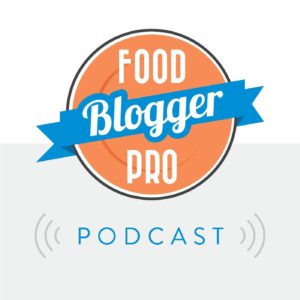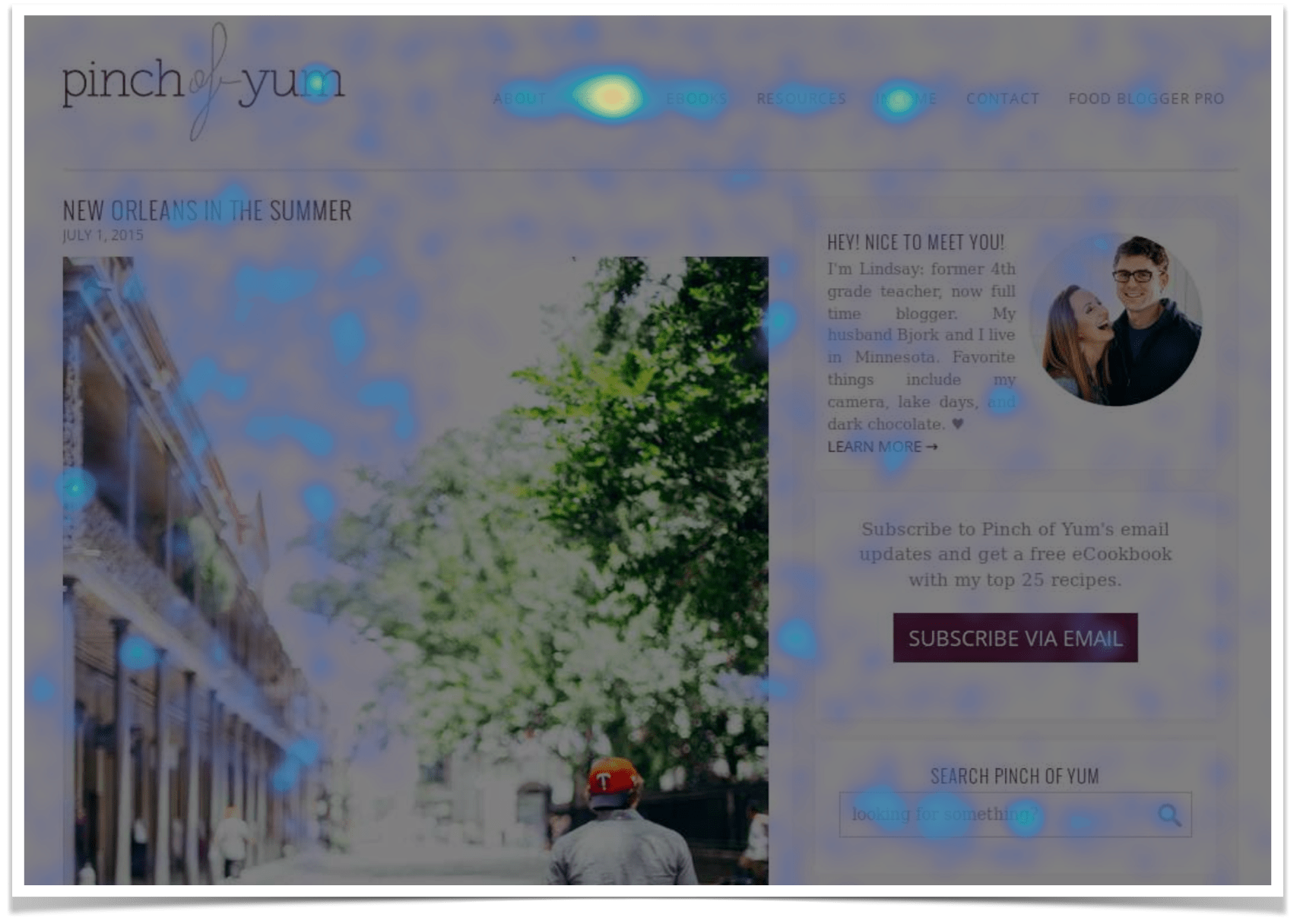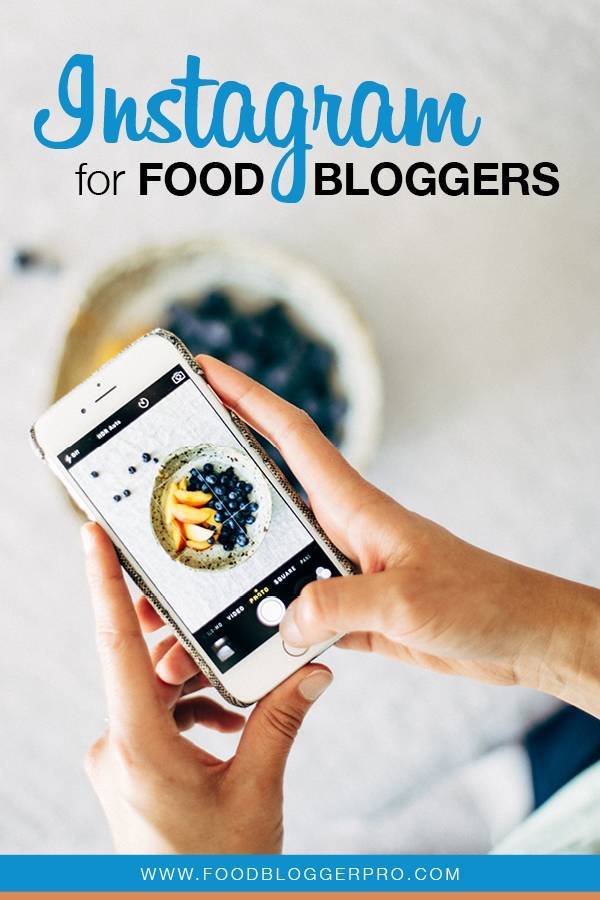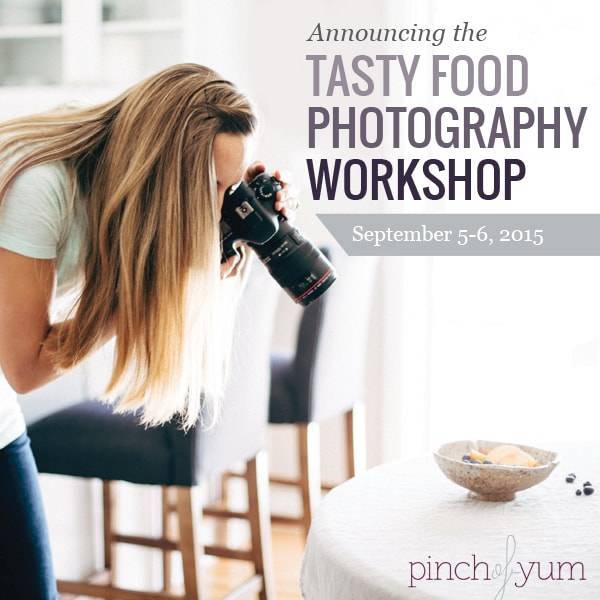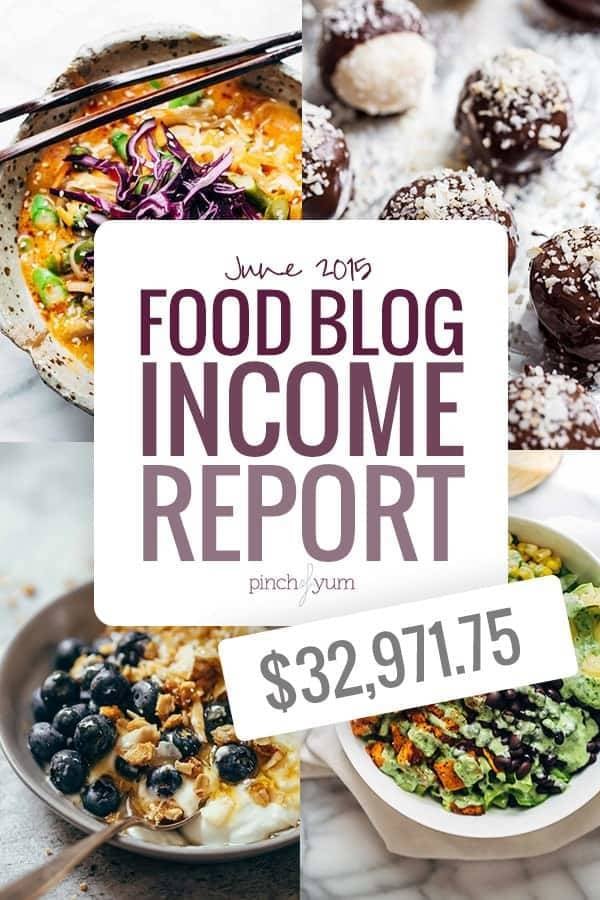

Hiya friends!
Bjork here. Lindsay and I are back at it this month after last month’s Q&A report. Thanks to everyone that submitted a question.
You new ’round these parts, pardner? If so, pull up that thar chair and lemme explain what this post is all about.
Many moons ago Lindsay and I decide to do an experiment. In a moment of (un)inspired brainstorming we decided to call it “The Food Blog Money Making Experiment.” Indeed, the name wasn’t creative, but it was clear: we were going to experiment with creating an income from a food blog.
Every month Lindsay and I tally up the numbers, take screenshots, review notes, draft, erase, re-write, research, message back and forth, email back and forth, organize, compile, re-organize, and eventually publish all of the things that we’ve learned from the previous month. The things that work, the things that didn’t work, and the things that we’re excited about moving forward.
If you look at that first report you’ll see that the income created from the blog has grown substantiality over the 3+ years that we’ve been doing this experiment (from about $20 to $20-30k). There are few reasons for that:
- Time and hard work. We’ve been doing these reports for over three years, and Lindsay has been working on Pinch of Yum for over five years. That’s a lot of time and hard work. Keep in mind that those first few years represent a time when we were putting in work without getting anything back – like, zero income. It was like a really long, unpaid internship.
- Lots of quality content. When you’re building a content driven website (which most food blogs are) it takes a lot of quality content (see #1 above) before your proverbial snowball-down-a-hill can get big enough to create a decent amount of traffic, and therefore income.
- These reports. These reports, while not the focus of the blog, have allowed us to talk about the business of blogging, which makes it easier to generate affiliate income from hosting and theme-related products (i.e. Bluehost, Genesis, Elegant Themes).
- Two people. Don’t forget! Both Lindsay and I are working on this together.
- Luck. Luck is always a factor, and it’s something we’ve experienced with Pinch of Yum in different ways throughout the past few years. We also believe that luck wears overalls and looks a lot like work (see #1).
Regarding #1 – I’ve done over 10 interviews for the Food Blogger Pro podcast (more on that later!) and I’ve noticed the consistent thread throughout every interview has been time and hard work. We call it 1% infinity. You get a little bit better, every day, over a long period of time. If you can do that you can do a lot of things. It’s our story, it’s the story of the people we’ve interviewed, and it can be your story as well.
So wherever you are and whatever it is that you’re doing our hope for you is this: that you do your thing, that you continue doing it, and that you try to get a little bit better each and every day.
Let’s take a look at the numbers for June.

A quick note: Some of the links below are affiliate links. All of the products listed below are products and services we’ve used before. If you have any questions about any of the income or expenses you can leave a comment and I’ll do my best to reply.
Income
- Sponsored Posts/Speaking – $13,700.00
- Bluehost – $6,210.00 –> this income comes from a page where we show people how to start a food blog in three easy steps.
- AdThrive – $5,689.88
- Yellow Hammer Media – $3,381.24
- Tasty Food Photography – $3,320.50
- sovrn – $2,357.42
- Gourmet Ads – $1,020.51
- Federated Media – $939.63
- Genesis Theme – $636.56
- How to Monetize Your Food Blog eBook – $595.00
- Swoop – $538.60
- Amazon Associates – $422.14
- Food Innovation Group – $293.02
- The Creamy Cauliflower Sauce eCookbook – $198.00
- Elegant Themes – $206.50
- Everyday Healthy eCookbook – $190.00
- AWeber – $28.80
Total Income: $39,727.80
Expenses
- Design Work – $2,515.00
- Support Staff – $935.70
- eBook Affiliates – $782.25
- Food Expenses – $555.51
- Amazon S3 and Cloudfront – $448.53
- PayPal Transaction Percentage – $319.30
- Media Temple (Hosting) – $275.00
- Rafflecopter – $117.00
- LeadPages – $67.00
- Adobe Creative Cloud – $53.55
- Facebook Advertising – $52.64
- MailChimp – $216.00
- Travel – $134.40
- Overwhelmingly – $79.00
- SumoMe – $30.00
- PayPal Website Payments Pro – $30.00
- Shoeboxed – $29.95
- QuickBooks – $26.95
- VaultPress – $20.00
- E-Junkie – $18.00
- Hello Bar – $15.00
- TailWind – $14.99
- Backupify – $12.00
- Apps/Software – $8.28
Total Expenses: $6,756.05
Net Profit: $32,971.75
If you’re interested in learning more about some of the ways that you can monetize a food blog, we encourage you to download this free ebook, “16 Ways to Monetize Your Food Blog,” from our sister site, Food Blogger Pro!
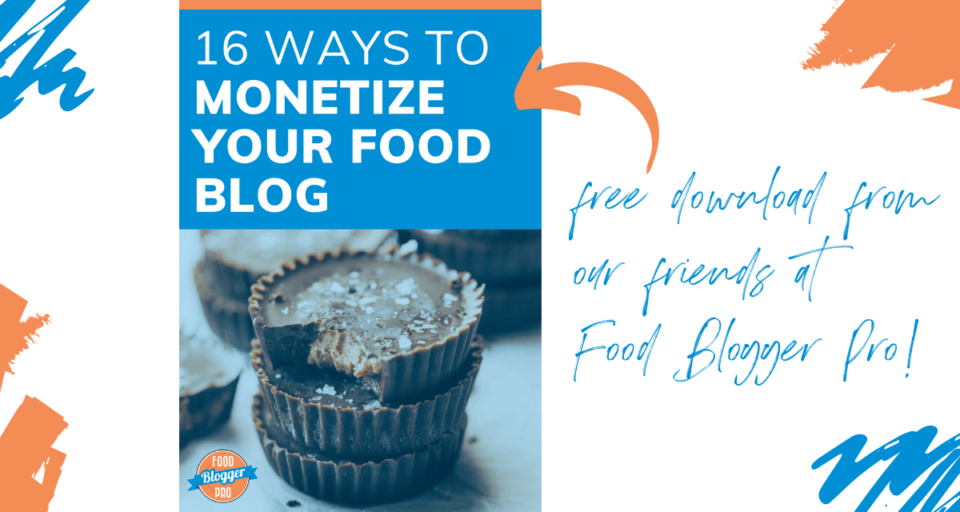
Traffic Totals
Below are some screenshots from Google Analytics. You can click on these images to view a larger size.
Traffic Overview

Top Ten Traffic Sources
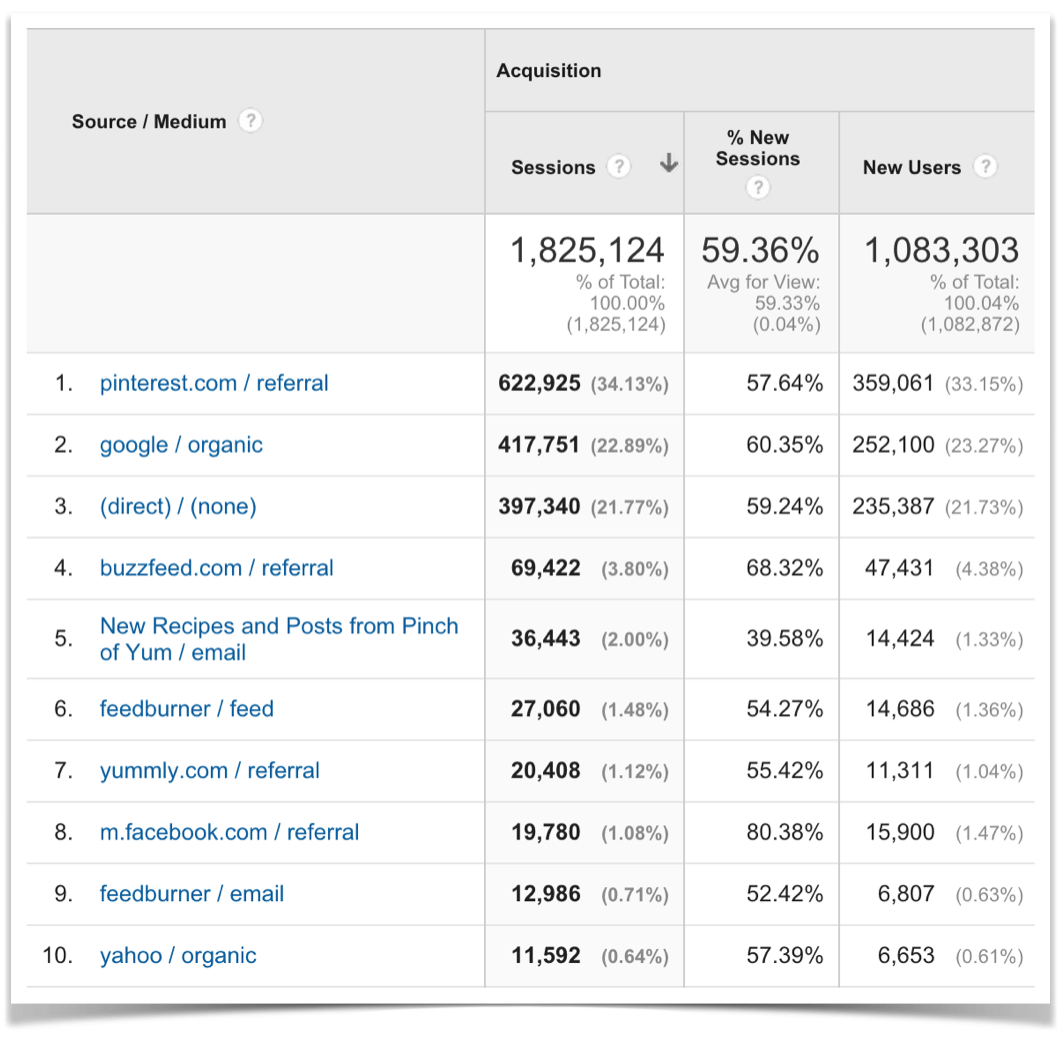
Mobile Vs. Desktop Vs. Tablet
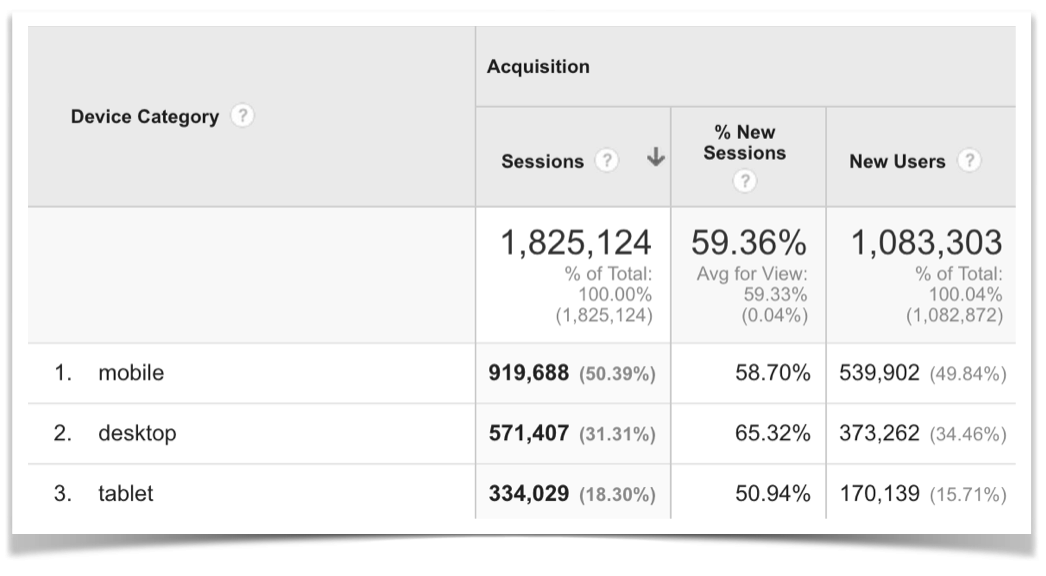
Top Traffic Channels
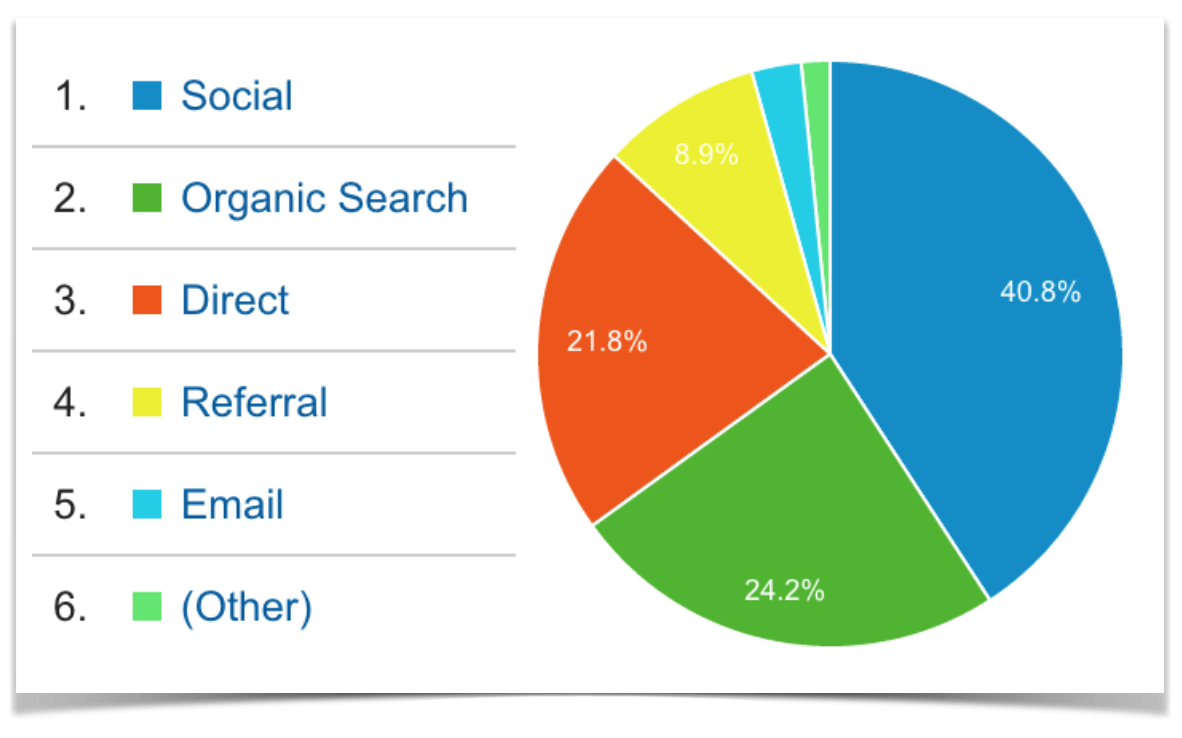

The Food Blogger Pro Podcast
We launched the Food Blogger Pro podcast last week. We couldn’t be more excited about it! We already have over 10 interviews recorded, three of which are published (see below). You can subscribe in iTunes, Stitcher, or your favorite audio player.
- Lindsay Ostrom from Pinch of Yum on life as a career blogger
- Bjork Ostrom from Food Blogger Pro on building a membership site from scratch
- Sally McKenney from Sally’s Baking Addiction on creating success
It’s been a huge undertaking to get the podcast up to speed, but now that we have a system in place it’s smooth sailing. Huge props to FBP team member Raquel for all her work in helping to launch it (and keep it going).
Podcast Downloads
We’ve had just over 3,000 podcast downloads at the time of publishing this post. Were you one of those downloads? If so, thanks! **high five/hip bump**
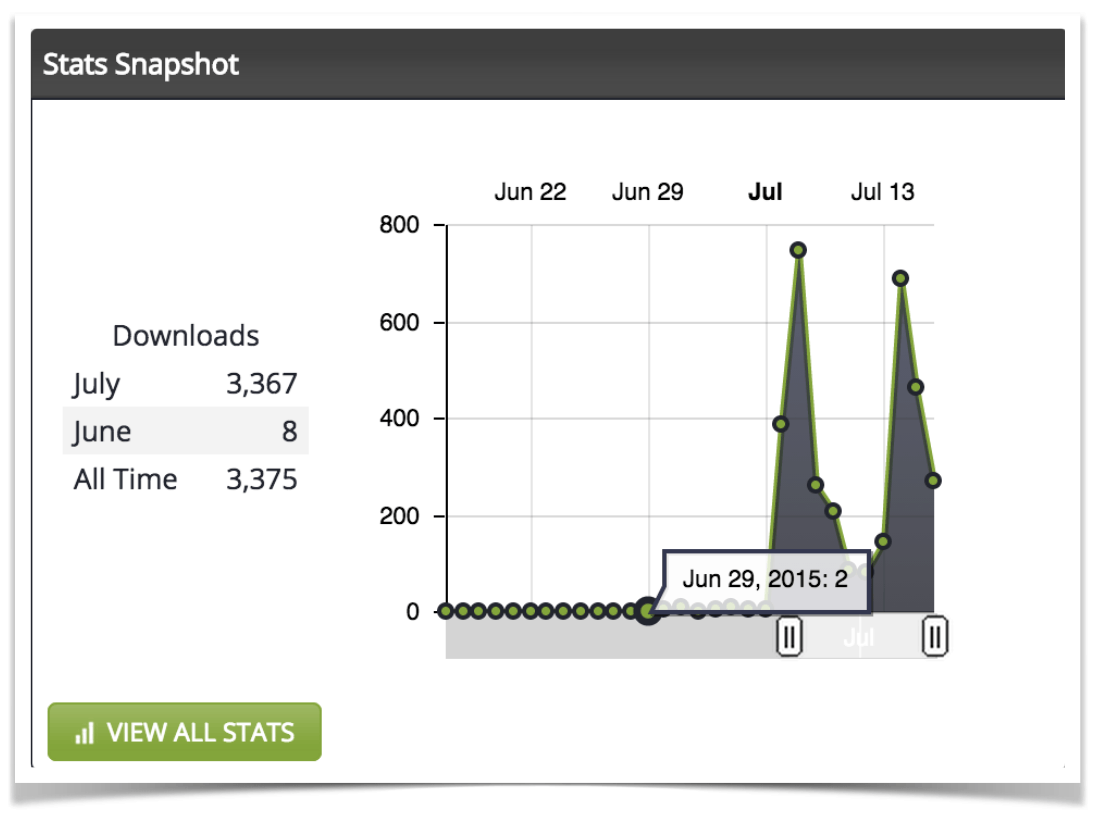
The Podcast Tools and Services we use
Curious about how a podcast is actually created?
Here’s a quick list of the tools we’re using for the podcast and how we use them (the links to Amazon are affiliate links).
- Skype – We use Skype to conduct the interviews. I always make sure to physically connect an ethernet cable (vs. using WiFi) as Skype’s WiFi connection has been spotty for me. I’ve purchased some credit with Skype that allows me to call someone on their phone if the interviewee prefers phone over Skype.
- Screenflow – I use Screenflow to record the podcast. This gives us two channels of audio to work with. One channel for my audio and one channel for the interviewees audio.
- Call Recorder for Skype – Plan Bs rule. Especially when it comes to audio and video. That’s why I always have a backup audio source. If Screenflow flops for some reason I have the audio from Call Recorder for Skype to fall back on.
- Heil PR-40 – This is the mic we use for recording. It’s awesome, especially for the price.
- SoundDevices USBPre2 – This is the pre-amp I use. It’s more than I need for a podcast, but it’s really good. I used this one for years when doing screencasts and it treated me well. It’s also $800 cheaper than the USBPre2, which is always nice. There are quite a few USB mics that won’t require you to use a pre-amp at all, like this one.
- Google Docs – We use a Google Docs spreadsheet to keep track of potential interviewees and completed interviews.
- ScheduleOnce – ScheduleOnce is a super slick scheduling software. It hooks into Google Calendar and automatically shows available times and lets people pick a slot that works for them. When someone picks a time the software adds the interview event to the calendar and sends out reminders to the interviewee. Super slick.
- Libsyn – Just like a website, a podcast has to be hosted. We use Libsyn to host our podcast. We upload the podcast to Libsyn, add the metadata, and press publish. This pushes the podcast out to podcast distributors like Stitcher and iTunes.
- Auphonic – Sometimes the audio levels are different between the interviewee and interviewer. Auphonic is a service that automatically levels the audio out. Not too loud. Not too soft. Just right.
- MusicBed – We used MusicBed to find royalty-free music for the podcast. It’s a really solid site for music. Not cheap, but it’s good!
What’s The Benefit Of a Podcast?
“Podcast, eh?” you say. “What’s the big deal with these things, anyways?”
Great question. The benefit depends on the business. Here’s what we see as the benefit for Food Blogger Pro with doing a podcast:
- Connected Content – It’s one thing to read what I write. It’s another thing to hear what I say. An audio podcast allows us to hang out with (i.e connect) with our audience when they’re not sitting in front of a computer. You could be at the gym, in the car, or on a run. It’s still content (just like a blog post), but it’s content that allows us to connect with people in a way that words on a screen can’t.
- Connect with Influencers – One of the things I’ve enjoyed most about the podcast so far is connecting with incredible people that do incredible work. In a sentence: It’s inspiring. I’m really excited for you to listen to some of the interviews we have queued up!
- Content Marketing – Our goal is for the Food Blogger Pro podcast to be a win-win-win. A win for the listener, a win for the interviewee, and a win for Food Blogger Pro. Content marketing at its best! It’s a win for the listener in that they’re (hopefully) learning new content, it’s a win for the interviewee in that they’re getting exposure to a new audience, and it’s a win for us in that we’re getting exposure and providing value as a part of the FBP brand.
Revisiting Long Pins Vs. Short Pins
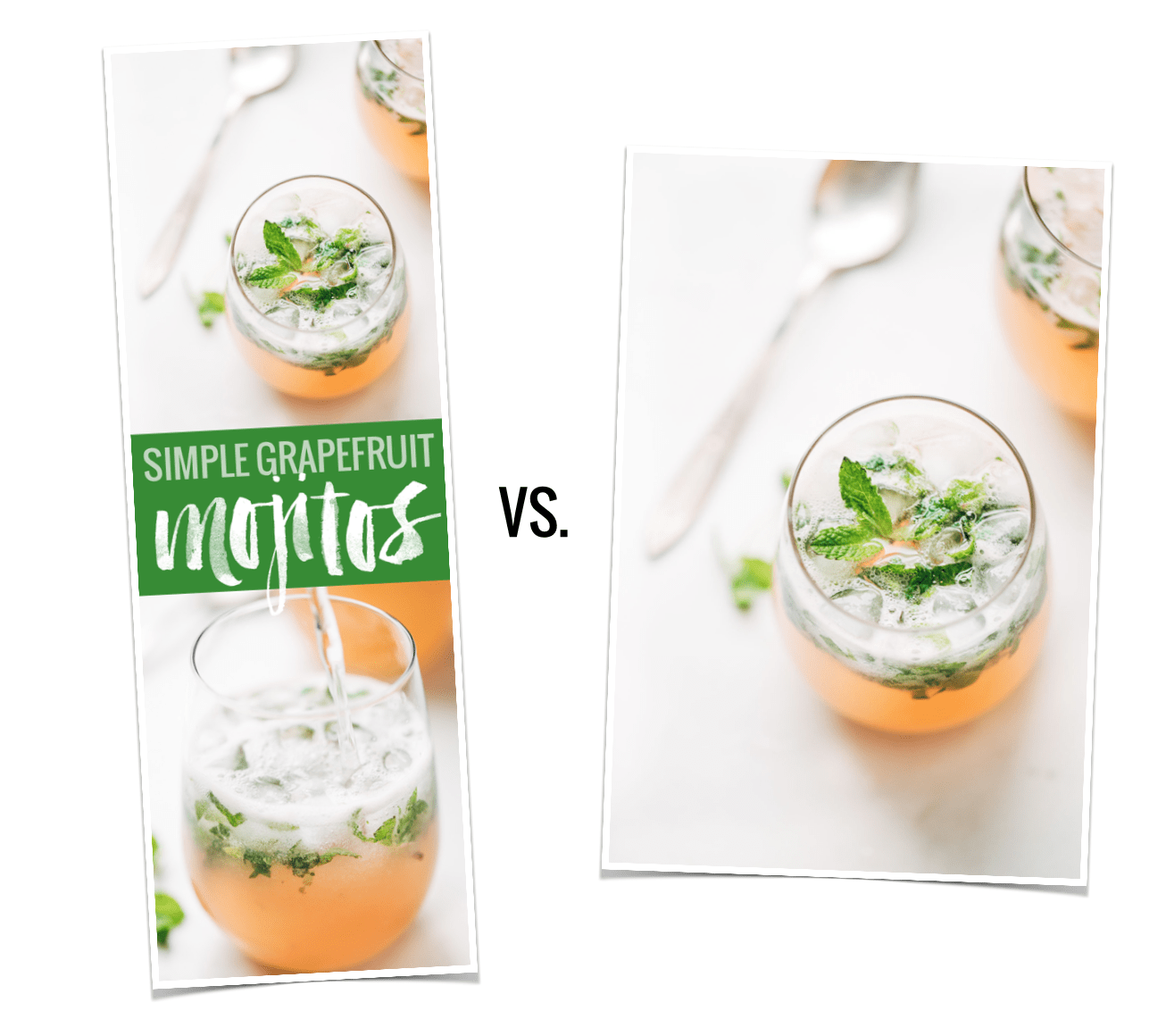

I thought I was done with the Pinterest analyzing, but I’m baaaaack! And I’m still talking about Pinterest.
There’s a good reason, though. As you might remember, in April we reported our findings that on average, long pins got 70% more repins than short pins. Whoa! You can read more about our little experiment and how we came to those numbers here.
After posting those numbers, we got a great question from Becca.
She asked if we had seen any correlation between the number of repins on those long images and the actual click activity. Essentially, do long pins actually result in more traffic to your blog?
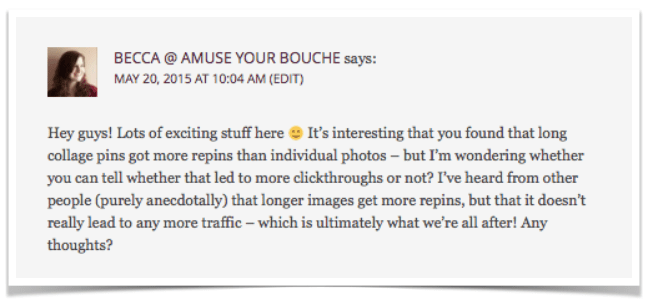
Abby (our amazing POY team member) and I went back to the analytics to see if we could find any correlations. Because we studied so many different boards to get our initial results, we decided to just take a quick glance at our Pinterest analytics to see which types of pins (long or short) were actually getting the most clicks to answer this second question.
We looked at the data from our top clicked pins (some of which were Pinch of Yum content and some of which were other people’s content) and we found that the long pins generated 54% more clicks than short pins. We also saw a really close correlation between the pins that were on that top clicked pin list and the pins that had gotten the most repins.
So when we look at our data, we see that yes, there is a correlation between repins and clicks, and yes, the long pins are getting repinned and clicked more than short pins.
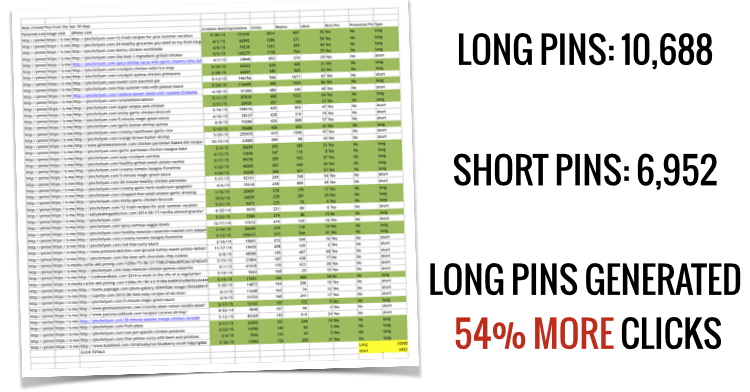
Like I said in the last report, this is valuable information with big implications, but we have to remember to take this information as a piece of a bigger picture.
First of all, this is a tiny sample size. I am only looking at my own analytics for my top 50 clicked pins. Small potatoes, guys.
Secondly, we know that social media changes, and we have to be ready to change with it. While we (Pinch of Yum) see long pins performing really well with repins and clickthroughs right now, we have to know that the performance of long pins and/or the ability to use them on Pinterest may or may not last.
I think it’s important to ask a few questions here.
Why do long pins work? Because they are attention-grabbing. They stand out.
Are they the end-all-be-all answer to food blogging? uhh, no.
What’s the takeaway?
- Make your content stand out in whatever way fits the social media platform that you’re using.
- Be creative.
- Be ready to change.
- Look at your numbers and act accordingly.
If you want to check out these numbers for yourself to see which types of pins are doing best for you, here’s where you can find that information! In your Pinterest analytics, find the Clicks tab and click the little tab in the top right-hand side of the window that says “export data.”
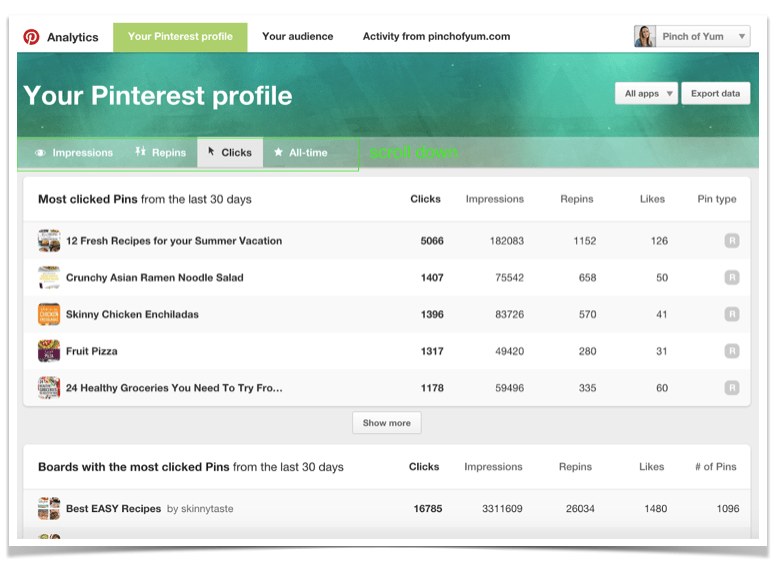
I’d like to say this will be my last segment on Pinterest for a while, but I make no promises. Good questions are worth digging into!
Hotjar

One of the new tools we’ve been using with Pinch of Yum and Food Blogger Pro is called Hotjar. It allows you to do two important things with your site: gather feedback and analyze changes.
Check out these screenshots for some examples.
Heatmap
A heatmap allows us to see the “hottest” parts of a page.
You can click here to see an interactive preview of that heatmap.
Interactive recording
A recording enables you to see mouse movement on designated pages.
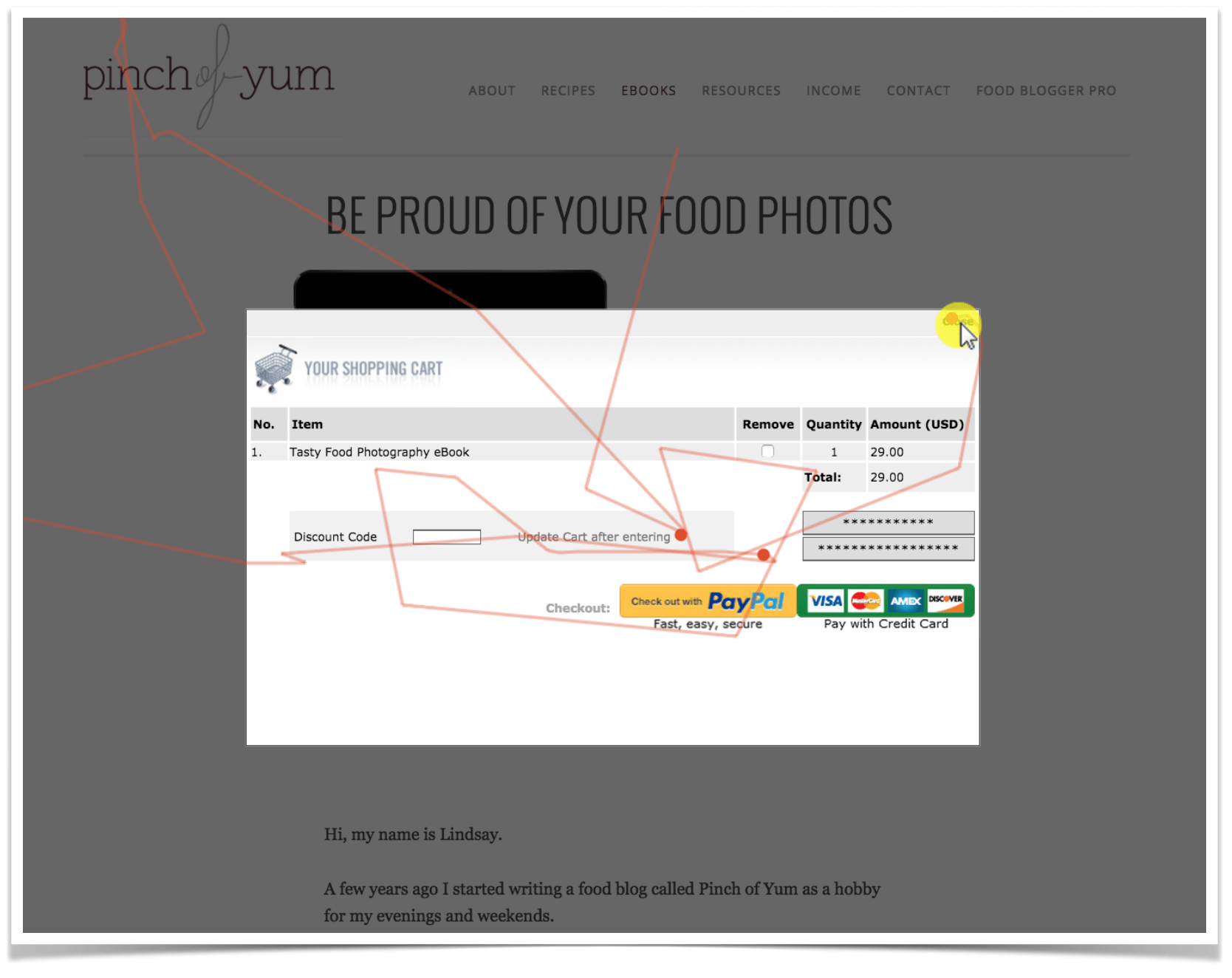
Polls
A poll allows you to easily ask your readers specific questions.
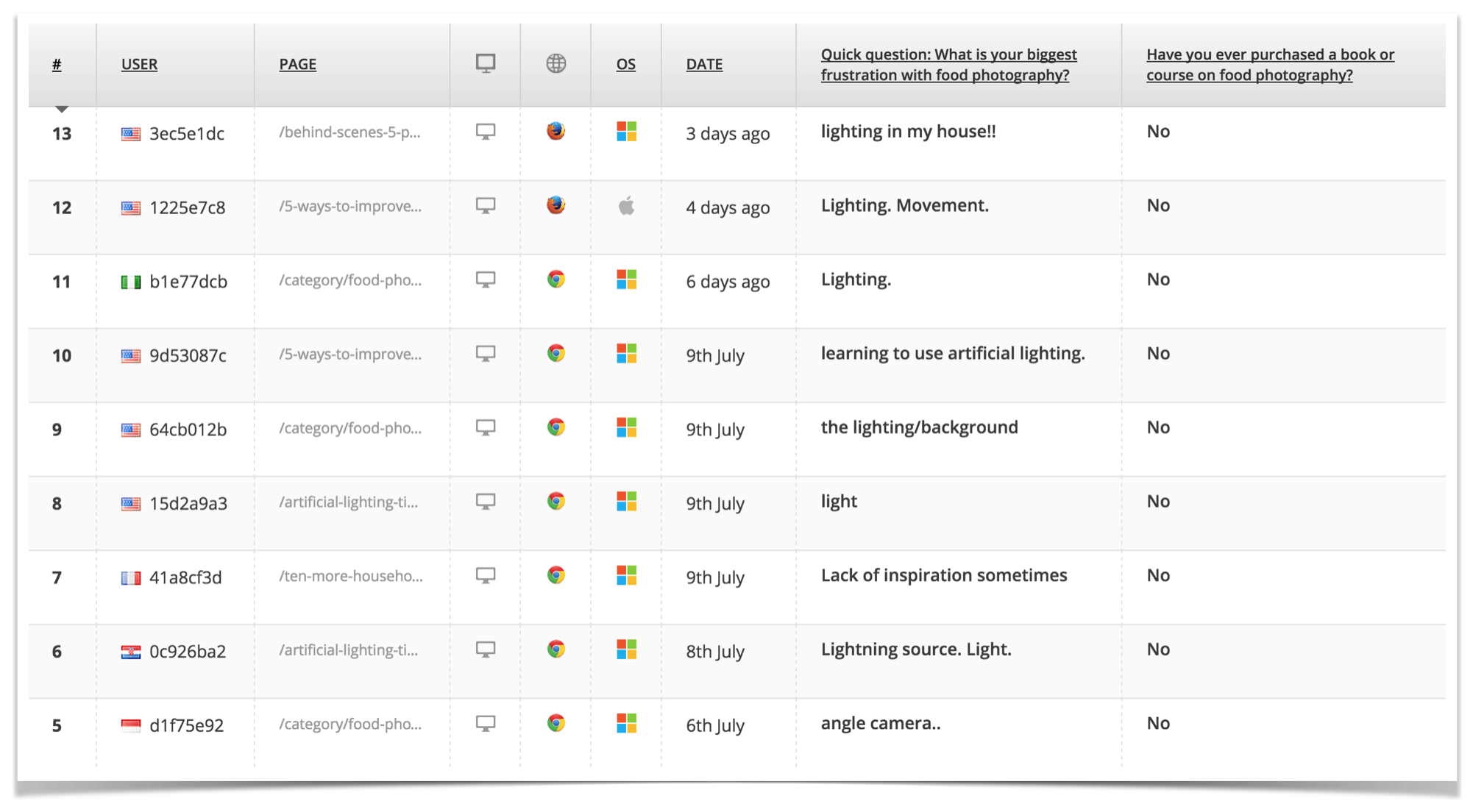
Why it’s noteworthy
The tools and services in Hotjar are really well designed and easy to use, but they aren’t new or revolutionary. What’s incredible about Hotjar is what you get for the price you pay. They have a free tier for bloggers that are just starting out and a really affordable tier ($29) if you want access to more data points.
I know you’ll learn something new about your blog if you implement some of the analysis tools. If nothing else it’s a cool party trick. “Hey, look at this cool heat map!” It’s a great tool to have in your virtual tool belt. I’d encourage you to check it out.
Food Blogger Pro members can check out the Hotjar course to learn how to set up and implement Hotjar on your blog.
Speaking of FBP…
New Course: Instagram For Food Bloggers

That’s right!
We have a brand new course that we JUST launched with 21 lessons packed with info to help you discover how food bloggers can and should be using Instagram to build their brand.
The Instagram for Food Bloggers course is available on Food Blogger Pro ($29/month for access to all courses – including this one) and the lesson outline was designed in a way that will hopefully make it easy to pick and choose what’s relevant for you.
If you’re completely new to Instagram, I recorded a few lessons that will help you start right at the beginning and get your account set up.
But if you’re already up and running, and/or you’re just not sure if what you’re doing on Instagram as a food blogger is actually effective, the strategy lessons will be more your style: how to gain followers, how to edit photos so they actually look good, hashtag best practices, and whether or not that little single clickable link in your Instagram bio is really worth your time. (Hint: I’d say YES.)
We also did a bonus lesson in this course that we’ve never done before – it’s all Q&A from the questions that Food Blogger Pro members asked about Instagram before the course launched. And surprise: I LOVE Q&A.
One thing that’s really fun about this course is the fact that we were able to create a setup where you will be able to see my phone on the screen as I do different things in the Instagram app. So as I talk about each concept, tip, or trick in the lessons, I can also demonstrate it all live on my iPhone. Too cool.
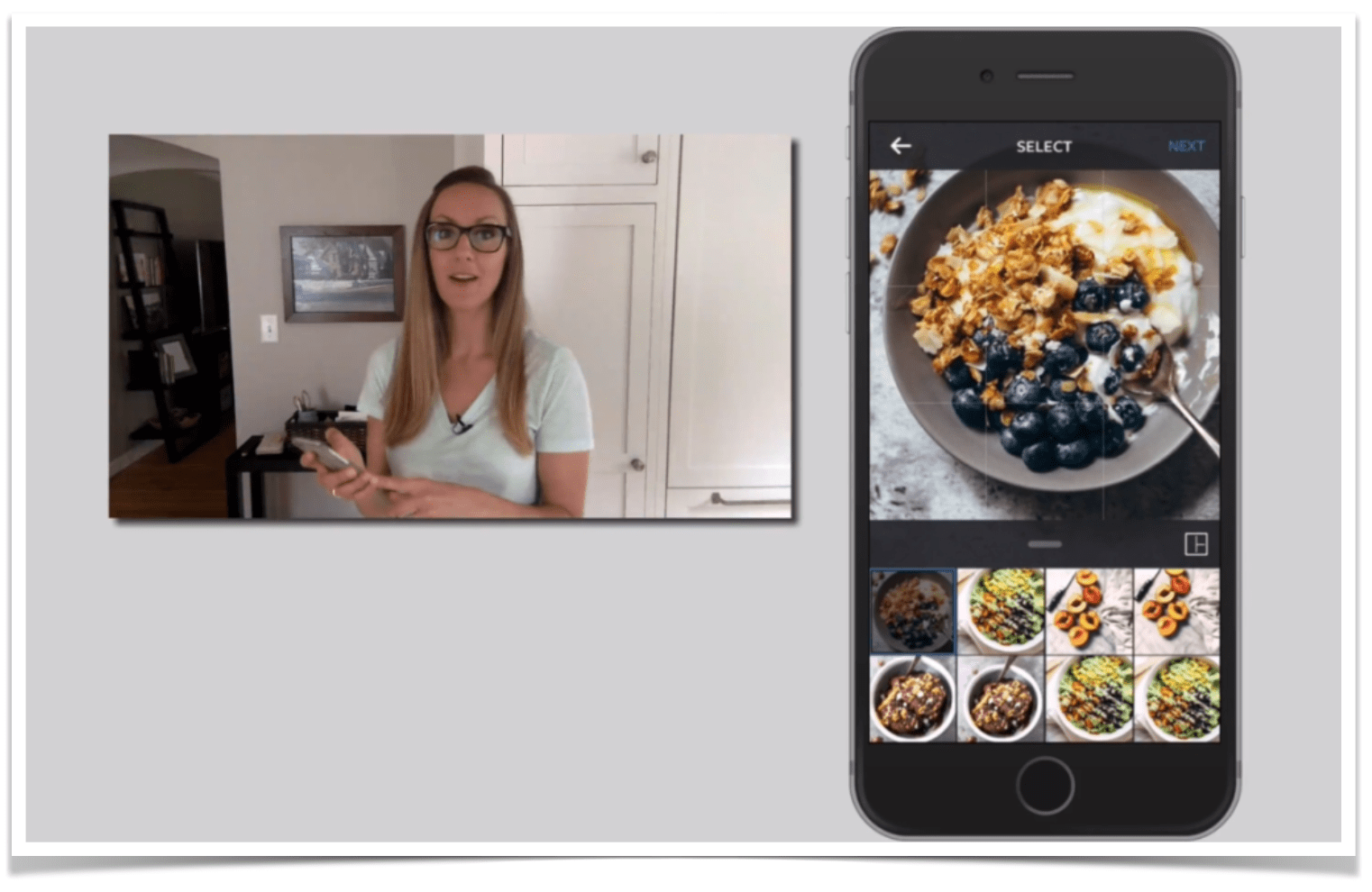
There is so much fun and practical stuff in this course – and best of all, Sage makes an appearance once or twice in the back corner of the video (perks of recording at home?) which, really, is the main selling point to the whole thing.

Do More Of What You Love

… without necessarily expecting anything of it.
Lately, I have needed more of this. So much of what I do at this point in the life of my blog is comments, project management, interviews, organizing photos and delegating and email marketing and bla bla bla – and these things aren’t necessarily about the means or the process, but about the potential end or the strategy behind it. And that’s a good thing sometimes, but it’s also sort of depressing. Anti-joyful. Soul sucking.
I’m not even dramatic AT ALL.
I’ve just been feeling this pressure lately like it’s time for me to go back to the means. I need to get the point where I’m working on something – anything – only because I love it and not because of “what might come from it.”
And this is how I feel about something that I’ve been working on for the last few weeks.
On Thursday, I made an announcement in my VIP group on Facebook about something that we’ve never ever done for Pinch of Yum before. We launched our first-ever workshop for Pinch of Yum called the Tasty Food Photography Workshop, which will be happening in Minneapolis in September.
To be honest, I was really excited about opening registration and also extremely nervous. Like what if nothing comes from it? What if it’s not financially worth it? What if it is a flop and we only have a one person who is interested, and it’s my mom? But the thing I kept coming back to was the pure joy of just doing it for the enjoyment and the love.
And the story has a happy ending: we sold out the workshop in just over 24 hours.
But regardless of what would have happened, it would have been a win, in a sense, because I am so excited to be doing this work that I feel refreshed, energized, back to the things that got me into it in the first place.
The takeaway, I guess, is that there is power in doing what you feel intrinsically motivated to do. Strategy is great. Thoughtful planning is really important. But the soul of the work is the driving force, and successful entrepreneurs are those people who can keep their soul alive and energized as they build and grow their businesses.
I’d love to hear your thoughts: How do you keep the heart and soul of your work alive?
The Dalai Lama Be Like…

I’ve been revisiting some books and blogs about minimalism over the past few weeks. I wouldn’t consider myself a minimalist, but whenever I spend time learning about it I always feel inspired. One quote, in particular, has really stuck with me this week:
“If one’s life is simple, contentment has to come. Simplicity is extremely important for happiness. Having few desires, feeling satisfied with what you have, is very vital: satisfaction with just enough food, clothing, and shelter to protect yourself from the elements.” – The Dalai Lama
“Having few desires.” Uff-da. That’s a tough one. Especially in a culture of work more, do more, be more, get more.
I’m trying to reconcile the reality of that quote with the reality of what we often talk about in these reports – the amount of hard work, hustle, and focus that it takes to grow and build a blog (or business or nonprofit).
I’d be curious to know: How do you process that quote? Do you think that having few desires is important for happiness?
Because Of You

It’s because of you that this thing we call Pinch of Yum can exist as it does today. Thank you so much for making these recipes, leaving comments with your love and feedback, and sharing this food around the table with your families and friends.
Every month we use a portion of the income from the blog to support a special project at The Children’s Shelter of Cebu. This month we’re supporting CSC by donating to help cover tuition for the older kids at the orphanage. Most CSC kids attend the Children of Hope School, which is integrated into CSC. But eventually the older students need to go to a school in Cebu City for higher grade levels – and that requires tuition payments.
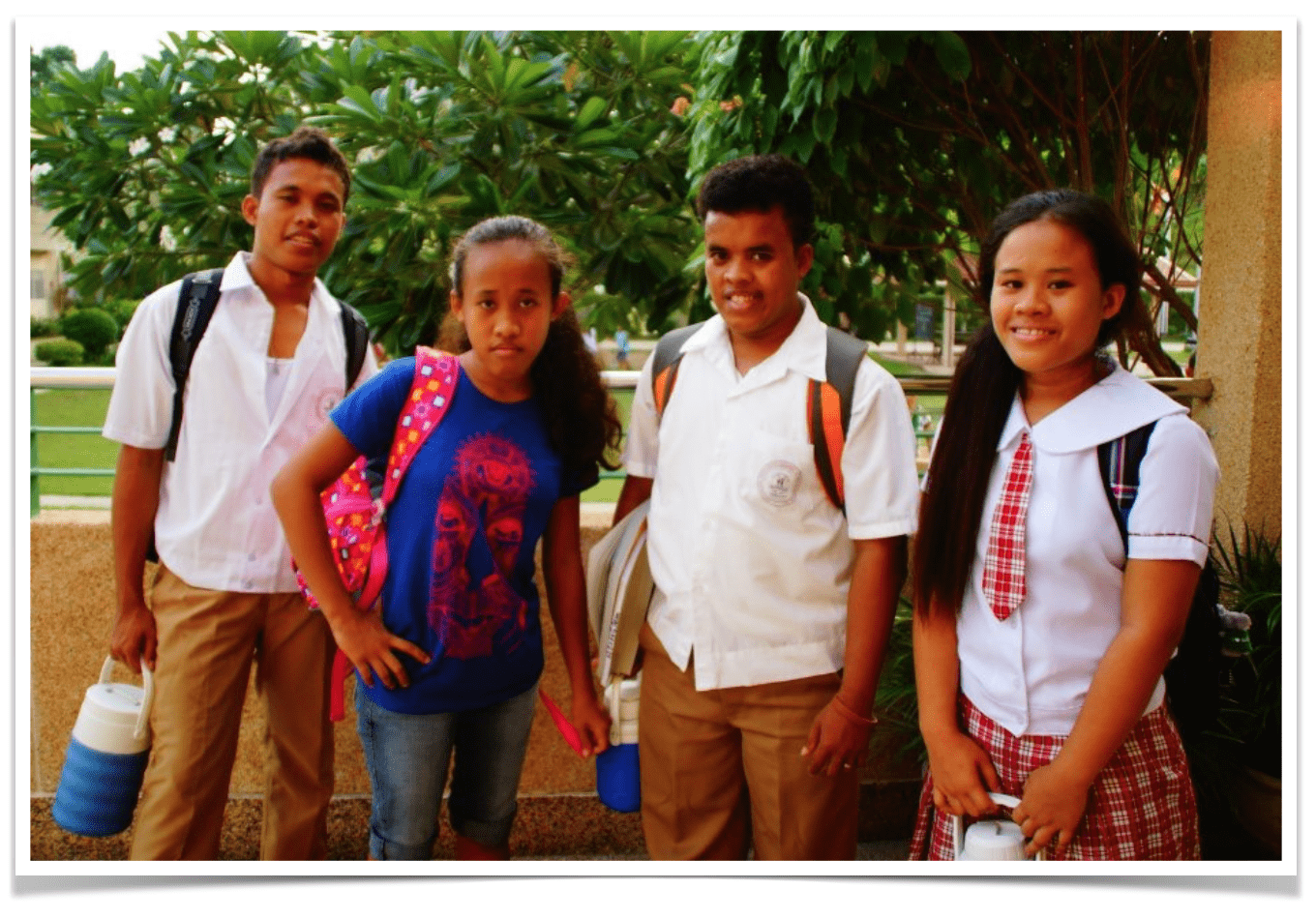
These are four kids that I had as students, and three out of four of them are now able to attend a local private high school to continue their education beyond what the Children of Hope school can provide.
Thanks so much for following along with Pinch of Yum. We really appreciate you.
The post June Traffic and Income Report – $32,971.75 appeared first on Pinch of Yum.

